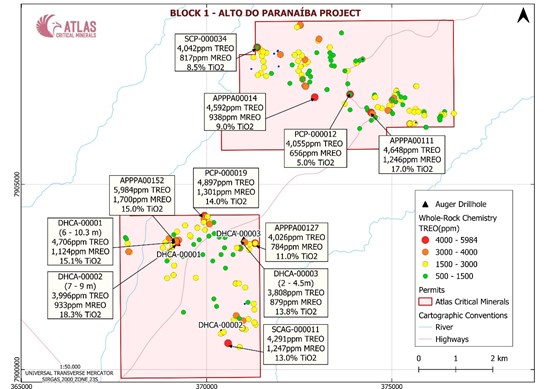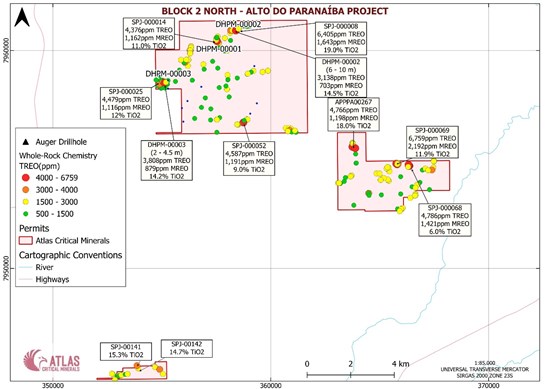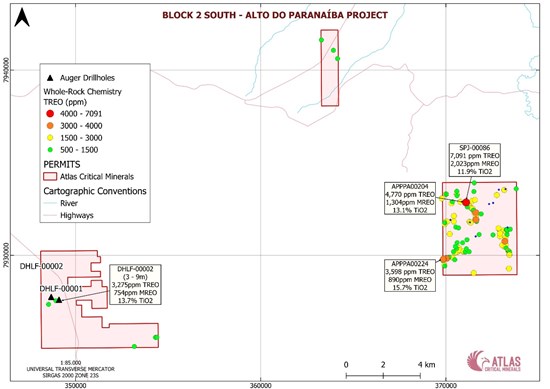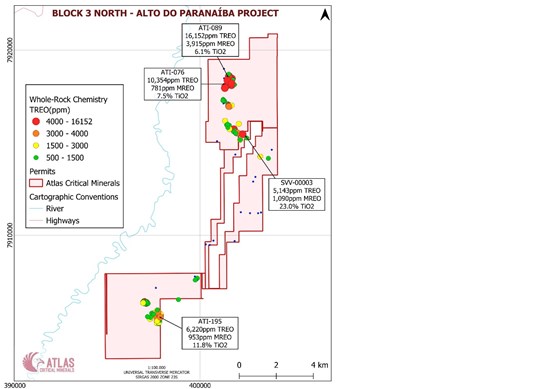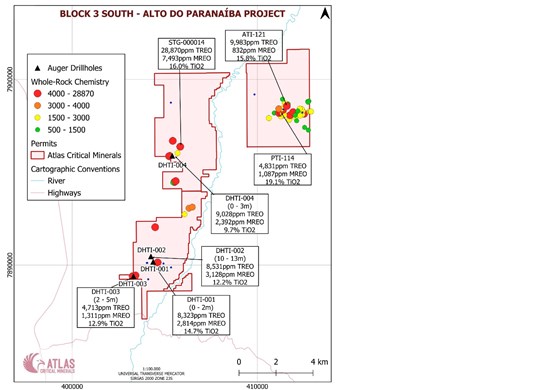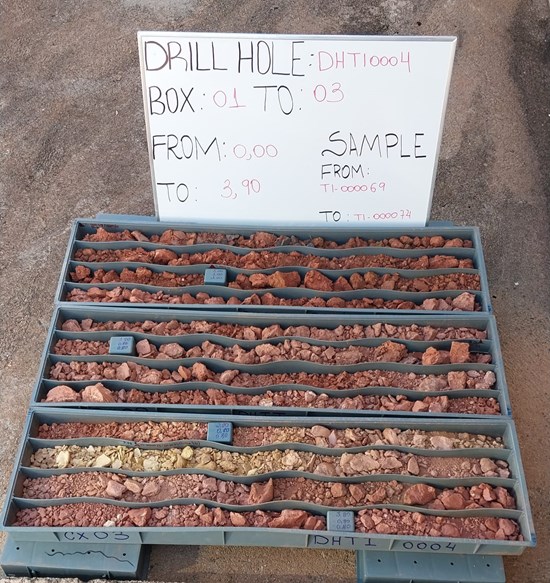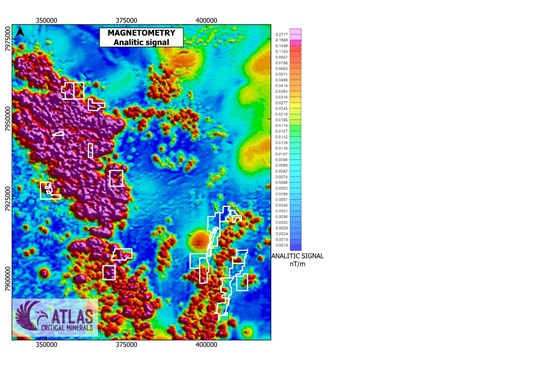Atlas Critical Minerals Reports Strong Initial Rare Earth and Titanium Results from Alto do Paranaiba Project
Rhea-AI Summary
Atlas Critical Minerals (OTCQB: JUPGF) has reported promising initial rare earth and titanium results from its Alto do Paranaíba Project in Minas Gerais, Brazil. The project, spanning over 25,000 hectares, has demonstrated significant near-surface mineralization potential.
Surface sampling across three exploration blocks revealed exceptional grades, with Block 3 showing the highest results of up to 28,870 ppm TREO and 23.2% TiO2. Initial auger drilling campaign, comprising 11 drillholes totaling 144 meters, confirmed high-grade, near-surface mineralization with notable intercepts including 12m @ 5,961 ppm TREO and 6m @ 7,729 ppm TREO.
The project's geological setting within the Mata da Corda Group, combined with intense laterization processes, has led to enrichment of titanium and rare earth elements in the weathered profile.
Positive
- High-grade surface samples with up to 28,870 ppm TREO and 23.2% TiO2
- Consistent high-grade mineralization across all three exploration blocks
- Shallow mineralization confirmed by initial drilling results
- Strategic 25,000-hectare land position in established mining jurisdiction
- Strong correlation between REE and titanium enables effective geophysical exploration
Negative
- Early-stage exploration project with limited drilling data
- Maximum drilling depth of only 21 meters - deeper mineralization yet unknown
- Project requires significant additional exploration to determine economic viability
News Market Reaction 1 Alert
On the day this news was published, JUPGF gained 41.10%, reflecting a significant positive market reaction.
Data tracked by StockTitan Argus on the day of publication.
Observed Surface Sample Grades up to 28,870ppm TREO and
Belo Horizonte, Brazil--(Newsfile Corp. - July 17, 2025) - Atlas Critical Minerals Corporation (OTCQB: JUPGF) ("Atlas Critical Minerals" or the "Company") is pleased to report strong initial rare earth and titanium results from its Alto do Paranaíba Project (the "Project"), located in the western part of state of Minas Gerais, Brazil. The project demonstrates significant potential for near-surface rare earth and titanium mineralization within the "Mata da Corda" Group geological sequence. SGS Canada, Inc. ("SGS") was retained to prepare technical reports under U.S. Regulation S-K 1300. In particular, Marc-Antoine Laporte and Yann Camus from SGS are Qualified Persons for the Project. SGS is well-known as a global leader in testing, inspection and certification of mineral properties and projects.
The Project comprises mineral rights totaling more than 25,000 hectares, strategically positioned within a major volcano-sedimentary geological sequence. The extensive Project area has been divided into three exploration blocks for ease of exploration activities as shown in Figure 1.
Figure 1 - Exploration Blocks of the Alto do Paranaíba Project
To view an enhanced version of this graphic, please visit:
https://images.newsfilecorp.com/files/6728/259070_cdd7d2d8b4778ada_002full.jpg
The Mata da Corda Group consists of the sedimentary Capacete Formation crosscut by the volcanic Patos Formation. This geological setting, with its geochemical signature confirmed to be related to Brazilian late Cretaceous Alkaline Provinces, provides outstanding exploration potential for mineralization for both rare earth elements and titanium.
Surface Sampling Results
The Company's initial exploration campaign has included 770 surface samples (rock and soil), which demonstrated consistently high grades across all three blocks:
Block 1 Highlights:
- 5,984 ppm TREO; 1,700 ppm MREO;
14.8% TiO2 (Sample APPPA00152) - 4,897 ppm TREO; 1,301 ppm MREO;
13.9% TiO2 (Sample PCP-000019) - 4,648 ppm TREO; 1,246 ppm MREO;
17.4% TiO2 (Sample APPPA00111)
Figure 2 - Block 1 Surface Sampling Results Map Indicating Widespread High-Grade TREO Mineralization (>1,500ppm)
To view an enhanced version of this graphic, please visit:
https://images.newsfilecorp.com/files/6728/259070_cdd7d2d8b4778ada_003full.jpg
Block 2 Highlights:
- 7,091ppm TREO; 2,023 ppm MREO;
11.9% TiO2 (Sample SPJ-00086) - 6,759 ppm TREO; 2,191 ppm MREO;
12.0% TiO2 (Sample SPJ-00069) - 6,405 ppm TREO; 1,643 ppm MREO;
18.6% TiO2 (Sample SPJ-00008)
Figure 3 - Block 2 North Surface Sampling Results Highlighting Multiple High-Grade Zones
To view an enhanced version of this graphic, please visit:
https://images.newsfilecorp.com/files/6728/259070_cdd7d2d8b4778ada_004full.jpg
Figure 4 - Block 2 South Surface Sampling Results Showing Strong Grades in Specific Locations
To view an enhanced version of this graphic, please visit:
https://images.newsfilecorp.com/files/6728/259070_cdd7d2d8b4778ada_005full.jpg
Block 3 Highlights:
- 28,870 ppm TREO; 7,493 ppm MREO;
16.5% TiO2 (Sample STG-000014) - 16,152 ppm TREO; 3,915 ppm MREO;
6.1% TiO2 (Sample ATI-089) - 10,586 ppm TREO; 679 ppm MREO;
12.7% TiO2 (Sample ATI-025) 23.2% TiO2 (Sample SVV-00003)
Figure 5 - Block 3 North Surface Sampling Results Demonstrating Extensive Mineralization and Results up to 16,152 ppm TREO
To view an enhanced version of this graphic, please visit:
https://images.newsfilecorp.com/files/6728/259070_cdd7d2d8b4778ada_006full.jpg
Figure 6 - Block 3 South Surface Sampling Results Including Highest-Grade Intercepts
To view an enhanced version of this graphic, please visit:
https://images.newsfilecorp.com/files/6728/259070_cdd7d2d8b4778ada_007full.jpg
Initial Auger Drilling Campaign Delivers Strong Near-Surface Results
Initial auger drilling comprised 11 drillholes totaling 144 meters, with 178 core samples analyzed (including
| HOLE ID | FROM | TO | LENGTH | TREO (ppm) | MREO (ppm) | TiO2 (%) |
| DHTI-001 | 0 | 21 | 21 | 5,139 | 1,391 | 13.82 |
| DHTI-001 | 0 | 12 | 12 | 5,961 | 1,690 | 13.27 |
| DHTI-001 | 0 | 3 | 3 | 7,467 | 2,452 | 13.22 |
| DHTI-001 | 7 | 12 | 4 | 5,825 | 1,446 | 16.34 |
| DHTI-002 | 4 | 13.8 | 9.8 | 6,414 | 2,091 | 12.67 |
| DHTI-002 | 8 | 13.8 | 5.8 | 7,729 | 2,681 | 12.45 |
| DHTI-002 | 11 | 13 | 2 | 8,976 | 3,396 | 11.82 |
| DHTI-003 | 0 | 7 | 7 | 4,067 | 1,090 | 11.93 |
| DHTI-004 | 0 | 6 | 6 | 7,165 | 1,968 | 11.51 |
| DHTI-004 | 0 | 3 | 3 | 9,028 | 2,393 | 9.67 |
| DHCA-00001 | 2 | 10.3 | 8.3 | 3,999 | 993 | 14.28 |
| DHCA-00001 | 6 | 10.3 | 4.3 | 4,706 | 1,124 | 15.06 |
| DHCA-00002 | 3 | 10 | 7 | 3,442 | 821 | 15.95 |
| DHCA-00003 | 2 | 8 | 6 | 3,396 | 812 | 11.21 |
| DHPM-00002 | 4 | 10 | 6 | 3,007 | 682 | 14.03 |
| DHPM-00003 | 1 | 6 | 5 | 3,129 | 716 | 13.00 |
| DHLF-00001 | 3 | 9 | 6 | 3,275 | 754 | 13.76 |
Table 1 - Significant Drilling Intercepts from the Alto do Paranaíba Project Auger Drilling Campaign
- DHTI-001: 12m @ 5,961 ppm TREO; 1,690 ppm MREO;
13.3% TiO2 - DHTI-002: 6m @ 7,729 ppm TREO; 2,680 ppm MREO;
12.5% TiO2 - DHTI-003: 3m @ 4,713 ppm TREO; 1,311 ppm MREO;
12.9% TiO2 - DHCA-00001: 4.3m @ 4,706 ppm TREO; 1,124 ppm MREO;
15.1% TiO2 - DHCA-00002: 7m @ 3,442 ppm TREO; 821 ppm MREO;
15.9% TiO2 - DHCA-00003: 6m @ 3,396 ppm TREO; 812 ppm MREO;
11.2% TiO2 - DHPM-00002: 6m @ 3,007 ppm TREO; 682 ppm MREO;
14.0% TiO2 - DHPM-00003: 5m @ 3,129 ppm TREO; 716 ppm MREO;
13.0% TiO2 - DHLF-00001: 6m @ 3,275 ppm TREO; 754 ppm MREO;
13.8% TiO2
Figure 7 - Drill Core Sample DHTI-0004 (0-3.9m) Showing Clay-Hosted Mineralization with 3m @ 9,028 ppm TREO, 2,393 ppm MREO,
To view an enhanced version of this graphic, please visit:
https://images.newsfilecorp.com/files/6728/259070_cdd7d2d8b4778ada_008full.jpg
Average TREO grades by block demonstrate consistent mineralization: Block 1 averaged 3,157 ppm TREO; Block 2 averaged 2,312 ppm TREO; and Block 3 averaged 4,906 ppm TREO. Notably, Block 3 showed high Nd+Pr averages up to 1,108ppm.
Geological Setting and Mineralization Model
The Project area benefits from intense laterization processes typical of Brazil's tropical climate, which has led to enrichment of titanium and rare earth elements within the weathered profile. The mineralized sequence occurs within extensively oxidized zones of the Mata da Corda Group, with drilling reaching maximum depths of approximately 21 meters.
The strong positive correlation between rare earth elements and titanium, combined with the sequence's intense magnetism, makes the geological unit highly responsive to geophysical surveys, facilitating future exploration targeting.
Figure 8 - Magnetometry Analytic Signal Map Showing Strong Positive Anomalies Associated with Mata da Corda Group Mineralization
To view an enhanced version of this graphic, please visit:
https://images.newsfilecorp.com/files/6728/259070_cdd7d2d8b4778ada_009full.jpg
Quality Assurance/Quality Control
All samples were analyzed by SGS Geosol, considered to be the premier analytical laboratory in Brazil and used by major mining companies. Quality control samples, such as blanks, duplicates and standards (CRM) were inserted into each analytical batch. For all analysis methods, the average number of QA/QC represented
Terminology: TREO means Total Rare Earths Oxides, MREO means Magnetic Rare Earths Oxides, and TiO2 represents titanium dioxide.
About Atlas Critical Minerals Corporation
Atlas Critical Minerals Corporation (OTCQB: JUPGF) controls a large portfolio of critical mineral rights in Brazil, encompassing over 575,000 acres, and including projects in rare earths, titanium, and graphite — minerals essential for defense applications and electrification. Additionally, we own a quarry for high-quality quartzite and one of our iron ore projects is expected to start production during 2025.
Safe Harbor Statement
This press release contains forward-looking statements within the meaning of Section 27A of the Securities Act of 1933, as amended, and Section 21E of the Securities Exchange Act of 1934, as amended including the timing of commencement of the public offering and the ability of the Company to have its common stock listed on the Exchange. Forward-looking statements are based upon the current plans, estimates and projections of Atlas Critical Minerals and its subsidiaries and are subject to inherent risks and uncertainties which could cause actual results to differ from the forward-looking statements. Therefore, you should not place undue reliance on these forward-looking statements.
Risks related to the Company and its subsidiaries are discussed in the section entitled "Risk Factors" in the Company's Form 20-F filed with the Securities and Exchange Commission (the "SEC") on February 28, 2025. Please also refer to the Company's other filings with the SEC, all of which are available at www.sec.gov. In addition, any forward-looking statements represent the Company's views only as of today and should not be relied upon as representing its views as of any subsequent date. The Company explicitly disclaims any obligation to update any forward-looking statements.
Investor Relations
Brian W. Bernier
Vice President, Investor Relations
+1 (833) 661-7900
brian.bernier@atlas-cm.com
https://www.atlascriticalminerals.com/
@Atlas_Crit_Min

To view the source version of this press release, please visit https://www.newsfilecorp.com/release/259070







